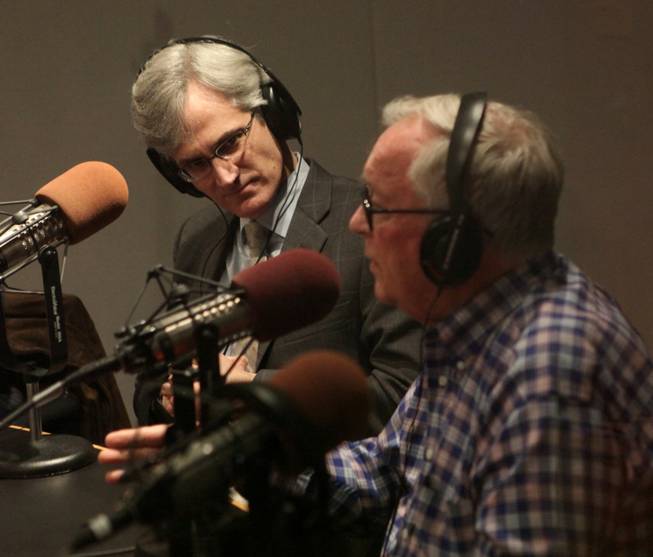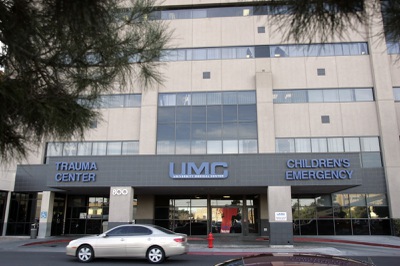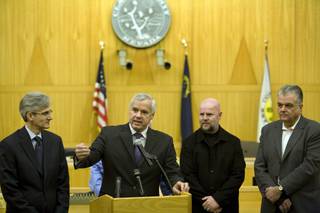
Clark County Commission Chairman Rory Reid, left, and former Chancellor Jim Rogers tape their “State of Nevada” radio show this week.
Friday, Jan. 22, 2010 | 2 a.m.
Wednesday news conference
Rory Reid and Jim Rogers are hoping the state’s struggling medical school can help transform Clark County’s failing public hospital into a world-class teaching hospital akin to what can be found at Johns Hopkins University.
Because Reid, the Clark County Commission chairman and Democratic gubernatorial candidate, has been on the board of the scandal-plagued University Medical Center for seven years, opponents say he should have done more to fix the problems at UMC before now. The hospital has been in the red for years and lost $71 million in the fiscal year that ended June 30.
Recently, Reid announced that Rogers, former chancellor of the Nevada System of Higher Education, would lead the effort to transform UMC. Rogers owns Sunbelt Communications, which operates 16 television affiliates in five states, including KVBC Channel 3 in Las Vegas. He is driven to produce results, and he is not afraid of stepping on toes.
As the Sun’s health care reporter, I joined radio producer Adam Burke in interviewing Reid and Rogers this week on KNPR 88.9-FM’s “State of Nevada” radio program.
The following is a transcript of that interview, condensed and edited for clarity.
Why so many problems at UMC?
Reid: UMC’s problems are an expression of problems with the health care delivery system in general. Most of the charity care in Clark County occurs at UMC, which benefits the private hospitals. This is a community problem, not UMC’s problem. I think we need to stand up and say that UMC’s business model does not work. We need to do something different.
What do you mean when you say you want to turn UMC into a “teaching hospital?”
Reid: Teaching occurs at UMC, but it’s not a teaching hospital. Johns Hopkins University is the largest employer in Maryland. It has become an enterprise that attracts millions of research and development dollars and private investment. It’s an engine for economic diversification. Why can’t we do that? The answer is that we can. It will be difficult. It will take a lot of work. But that should be our goal.
The top 20 hospitals in the country use a version of the academic model. If we create an academic teaching hospital, we can access the philanthropic community, and it will become a public-private partnership that will take the burden off the taxpayer and benefit all of us.
How will you achieve this?
Reid: Jim Rogers is a tenacious, passionate and forward-thinking advocate for education and health care. I was happy he was able to give his time, and we came together to do this with the Nevada System of Higher Education.
Rogers: You can’t just look at the hospital and say: “Wow, it’s losing money, there must be something terrible going on.” A third of the patients are uninsured. You can’t double the price you charge them because it’s still nothing.
We need to grow it from the inside. The University of Nevada School of Medicine does teaching in Reno and clinical work here in Las Vegas. In other states, the medical schools have partnered with a public hospital and said, “Together we can become successful.” We need academia to step up. But it’s a partnership that must go hand in hand with UMC.
You have referred to UMC and the medical school as “two poor children.” How can two weak partners combine to create one of the top teaching hospitals in the country?
Rogers: UMC has a lot of patients, 4,000 employees and it has a tremendous budget. But it can’t do the academic part. Then you have the smallest medical school in the United States and it must team up in some form with a hospital. If you put one and one together, you may end up with a 10. That’s where we need to go.
Is it just a matter of changing the will of the institutions so that they combine for greatness?
Reid: I think we need to create the centrifugal force to make this happen. UMC has a tremendous set of assets. It cost hundreds of millions to build. It will continue to attract patients. But it is shackled by a business model that does not work. We believe there’s a way to take that asset, along with our partner in the university system, and make it attractive to private investment. We’re going to look at every model around the country. Maybe a nonprofit should operate UMC and not the county.
This hasn’t happened before (at UMC) because nobody tried to do it. Other people have done this. I guarantee the day that Johns Hopkins starting talking about taking over that public hospital, it didn’t have a nickel in its budget for that. But it found a way to make one and one equal five, and that’s what we’re trying to do.
Some in the medical community can’t comprehend how this is possible.
Rogers: Going back in history, the medical school has never shown a great interest in Southern Nevada. Its people have been reluctant to push the growth down here. But given the population of this state, the medical school must grow. I was there five years as chancellor, and the medical school, frankly, did not do much in that five years.
Milton Glick (president of UNR) is supportive of this, and the regents are too. This is the first time everyone has come together under the health sciences system and looked forward saying: We need to develop the medical school in Southern Nevada. But we can’t do it without developing and collaborating with a hospital. For a long time, the UMC leadership had no interest either. I tried to call the former CEO on many occasions to get the higher education system involved. I never got a return call.
I don’t think you can fix this thing from the bottom up. You have to look at the structure.
Speaking of the structure, it’s widely known that Clark County commissioners don’t know how to run a public hospital. Should they continue to serve as its board of trustees?
Reid: If you’re going to fundamentally change the hospital you need to fundamentally change the governance structure. The problem you described is not one I’ll deny. We’ve tried to do a lot of things to make the hospital better, but we need more expertise and a new governance structure.
The Cleveland Clinic is already world-class and wants to expand in Las Vegas. Why not see if it wants to take over UMC and turn it into a teaching hospital?
Reid: As the leader on this initiative, my job is not to prejudge any ideas or push it in any direction. Everything should be on the table. We should look at every available structure out there and see if we can copy it.
Rogers: I’m sure we’ll call the Cleveland Clinic. I’m sure we’ll call the University of Pittsburgh. These are big-time players. They’ve been successful because they’ve been innovative. At least there are models out there. Once I figure out what is wrong with this structure, then the question is how do we fix this structure.
Commissioner Reid, your opponents for the governor’s seat have criticized UMC’s performance under your leadership. Some say this effort is just political cover while you run for governor.
Reid: In the seven years I’ve been working on UMC, we’ve done things to make it better and move forward and then taken steps backward along the way. I’ve realized this model is flawed. We need fundamental change.
That call for fundamental change simply hadn’t occurred because it was difficult and complicated. There were tremendous financial interests that might oppose it. To suggest this is being done for political reasons is unfounded. There is no way to know what the ultimate outcome will be. This may be a glorious success or it may be something less than that. The fact that I’m taking a risk and jumping off this cliff holding Jim Rogers’ hand says something about my leadership skills, not about a political calculation of some sort.
Will we know the outcome of this effort before the election in November?
Reid: No one knows the answer to that question, which is why it’s a risk. If I were thinking only politics, I wouldn’t have done this. I would have taken the safe course. But that’s not what I was elected to do. I was elected to the Clark County Commission and I’m going to be in that position for another year and I’m going to try and finish my job.



Join the Discussion:
Check this out for a full explanation of our conversion to the LiveFyre commenting system and instructions on how to sign up for an account.
Full comments policy